Insulin, a hormone produced by the pancreas, plays a vital role in regulating blood sugar levels and facilitating the uptake of glucose by cells for energy. In individuals with diabetes, either the body does not produce enough insulin (type 1 diabetes) or cannot effectively use the insulin it produces (type 2 diabetes), necessitating external insulin therapy to manage blood glucose levels. Over the years, advancements in insulin pharmacology have led to the development of various types of insulin formulations, each with unique characteristics tailored to meet the diverse needs of individuals with diabetes. This article provides an extensive overview of the different types of insulin available, their onset and duration of action, administration methods, and clinical considerations.
Understanding the Basics: Insulin Physiology
Before delving into the intricacies of insulin therapy, it is essential to grasp the fundamental principles of insulin physiology. Insulin acts as a key that unlocks cells, allowing glucose to enter and be utilized for energy production. In addition to regulating glucose metabolism, insulin influences lipid and protein metabolism and plays a crucial role in maintaining overall metabolic homeostasis.
Insulin secretion is finely regulated by complex physiological mechanisms in response to changes in blood glucose levels. After a meal, blood glucose concentrations rise, triggering the release of insulin from pancreatic beta cells. This insulin surge facilitates glucose uptake by peripheral tissues, suppressing hepatic glucose production and promoting glycogen synthesis and storage. Between meals or during periods of fasting, insulin secretion decreases, allowing for the release of stored glucose from the liver to maintain blood glucose levels within a narrow range.
Classification of Insulin: Understanding the Spectrum
Insulin formulations are classified based on several factors, including their source, onset and duration of action, and pharmacokinetic profiles. Broadly, insulin types can be categorized as follows:
1. Rapid-acting Insulin: Rapid-acting insulins have a quick onset of action, typically within 15 minutes of administration, and reach peak levels within 1 to 2 hours. They are designed to mimic the physiological insulin response to mealtime glucose spikes, helping control postprandial hyperglycemia. Common rapid-acting insulins include insulin lispro, insulin aspart, and insulin glulisine. These insulins are usually administered shortly before or immediately after meals to manage blood glucose excursions effectively.
2. Short-acting (Regular) Insulin: Short-acting insulins, also known as regular insulin, have a slower onset of action compared to rapid-acting insulins, typically taking effect within 30 to 60 minutes after injection. They peak within 2 to 4 hours and have a duration of action of approximately 6 to 8 hours. Regular insulin is often used to cover basal insulin needs, manage hyperglycemia between meals, and control blood glucose levels during periods of fasting.
3. Intermediate-acting Insulin: Intermediate-acting insulins have an onset of action of 1 to 2 hours, peak between 4 to 12 hours, and last for approximately 12 to 18 hours. These insulins provide basal insulin coverage and help maintain stable blood glucose levels throughout the day. NPH insulin (neutral protamine Hagedorn) is the most commonly used intermediate-acting insulin, characterized by its cloudy appearance due to the addition of protamine to prolong its action.
4. Long-acting Insulin: Long-acting insulins have a slow and steady onset of action, with minimal or no pronounced peak effect. They provide basal insulin coverage for an extended duration, typically lasting between 18 to 24 hours or longer, depending on the formulation. Long-acting insulins are designed to provide a consistent level of insulin activity between meals and overnight. Examples include insulin glargine (Lantus), insulin detemir (Levemir), and insulin degludec (Tresiba).
5. Ultra-long-acting Insulin: Ultra-long-acting insulins represent the latest innovation in insulin therapy, offering an even more extended duration of action compared to traditional long-acting insulins. These insulins form stable depots at the injection site, resulting in a slow and continuous release of insulin over an extended period. Insulin degludec (Tresiba) is currently the only ultra-long-acting insulin available, with a duration of action exceeding 42 hours.
6. Mixed Insulin Preparations: Mixed insulin formulations combine two types of insulin (e.g., rapid-acting and intermediate-acting) in fixed ratios to provide both mealtime and basal insulin coverage in a single injection. These premixed insulins offer convenience and simplicity, particularly for individuals who require a combination of rapid-acting and basal insulin therapy. Common examples include biphasic insulin aspart and biphasic insulin lispro.
Factors Influencing Insulin Selection and Administration
Choosing the most appropriate insulin regimen for an individual with diabetes requires careful consideration of various factors, including:
1. Type of Diabetes: The type of diabetes (type 1 or type 2) influences insulin requirements and treatment goals. Individuals with type 1 diabetes require exogenous insulin to survive, whereas those with type 2 diabetes may initially manage their condition with lifestyle modifications, oral antidiabetic medications, or non-insulin injectables before progressing to insulin therapy.
2. Patient Preferences and Lifestyle: Patient preferences, lifestyle factors, and treatment adherence play a significant role in insulin therapy selection. Factors such as meal patterns, activity level, work schedule, and needle phobia may influence the choice of insulin formulation, injection technique, and frequency of administration.
3. Insulin Sensitivity and Resistance: Insulin sensitivity, or the body’s response to insulin, varies among individuals and may change over time due to factors such as weight gain, physical activity, and medication use. Insulin resistance, commonly observed in individuals with type 2 diabetes, necessitates higher insulin doses to achieve glycemic control.
4. Timing and Flexibility: The timing of insulin administration relative to meals, physical activity, and sleep patterns affects blood glucose regulation and insulin efficacy. Flexible insulin regimens allow for adjustments in insulin dosing and timing based on individual needs, facilitating optimal glycemic control while minimizing the risk of hypoglycemia.
5. Injection Devices and Techniques: The availability of insulin delivery devices, such as insulin pens, syringes, and insulin pumps, offers flexibility and convenience in insulin administration. Proper injection technique, rotation of injection sites, and adherence to injection guidelines are essential for optimizing insulin absorption, minimizing injection site reactions, and reducing the risk of lipohypertrophy (localized fat accumulation).
Clinical Considerations and Special Populations
In addition to the general principles of insulin therapy, certain clinical considerations apply to specific populations and clinical scenarios:
1. Pediatric Patients: Insulin requirements in children and adolescents with type 1 diabetes vary based on factors such as age, growth rate, pubertal development, and activity level. Pediatric insulin regimens often involve a combination of rapid-acting and long-acting insulins, with adjustments made to accommodate fluctuations in insulin sensitivity and carbohydrate intake.
2. Pregnancy and Gestational Diabetes: Pregnancy induces physiological changes in insulin sensitivity and glucose metabolism, increasing the risk of gestational diabetes mellitus (GDM) in some women. Optimal glycemic control during pregnancy is essential for maternal and fetal health, often requiring adjustments to insulin doses and monitoring frequency under the guidance of healthcare providers specializing in maternal-fetal medicine.
3. Elderly Population: Older adults with diabetes may have comorbidities, functional limitations, and cognitive impairments that influence their ability to manage insulin therapy effectively. Simplified insulin regimens, regular monitoring, caregiver involvement, and attention to medication adherence are crucial for minimizing the risk of hypoglycemia and achieving glycemic targets in elderly patients.
4. Renal Impairment: Renal impairment can affect insulin clearance and metabolism, potentially altering insulin pharmacokinetics and dosing requirements. Individuals with renal dysfunction, including those on hemodialysis or peritoneal dialysis, may require adjustments to their insulin regimen to prevent hypoglycemia and optimize glycemic control.
5. Cognitive and Visual Impairments: Cognitive and visual impairments can pose challenges in insulin administration and self-management for some individuals with diabetes. Simplified insulin regimens, assistive devices, caregiver assistance, and patient education tailored to the individual’s needs are essential for promoting safe and effective insulin therapy in this population.
Emerging Trends and Future Directions
The field of insulin therapy continues to evolve with ongoing research and technological advancements aimed at improving treatment outcomes and enhancing patient experience. Some emerging trends and future directions in insulin therapy include:
1. Closed-loop Insulin Delivery Systems: Closed-loop or artificial pancreas systems combine continuous glucose monitoring (CGM) with automated insulin delivery algorithms to provide real-time glucose-responsive insulin dosing. These systems offer the potential for tighter glycemic control, reduced hypoglycemia risk, and enhanced quality of life for individuals with diabetes.
2. Ultra-rapid-acting Insulins: The development of ultra-rapid-acting insulins with accelerated onset and shorter duration of action holds promise for more closely mimicking physiological insulin secretion and addressing postprandial hyperglycemia more effectively. Ultra-rapid-acting insulins may offer greater flexibility in mealtime insulin dosing and timing, particularly for individuals with unpredictable eating patterns or gastroparesis.
3. Targeted Insulin Delivery Strategies: Targeted insulin delivery approaches, such as oral insulin formulations, inhaled insulin, and transdermal insulin patches, aim to improve insulin absorption, reduce injection burden, and enhance treatment adherence. These alternative delivery methods offer potential advantages in terms of convenience, pain reduction, and patient acceptance, although further research is needed to optimize their safety and efficacy.
4. Personalized Insulin Therapy: The concept of personalized or precision medicine in diabetes care involves tailoring treatment strategies to individual patient characteristics, including genetic factors, metabolic profiles, lifestyle preferences, and psychosocial considerations. Advances in genetic testing, pharmacogenomics, and digital health technologies hold promise for optimizing insulin therapy outcomes and minimizing treatment-related complications through personalized approaches.
5. Biosimilar Insulins: Biosimilar insulins, which are highly similar but not identical to reference insulin products, offer cost-effective alternatives to brand-name insulins while maintaining comparable safety and efficacy profiles. The availability of biosimilar insulins may improve access to insulin therapy for individuals with diabetes, enhance market competition, and potentially lower healthcare costs.
Conclusion
The landscape of insulin therapy is characterized by a diverse array of insulin formulations, delivery devices, and treatment strategies designed to meet the individualized needs of individuals with diabetes. Understanding the various types of insulin available, their pharmacokinetic properties, and clinical applications is essential for healthcare providers to tailor treatment regimens, optimize glycemic control, and improve patient outcomes. As research continues to advance and technology evolves, the future of insulin therapy holds promise for further innovations in precision medicine, targeted delivery systems, and personalized approaches to diabetes care, ultimately empowering individuals with diabetes to live healthier, more fulfilling lives.

























